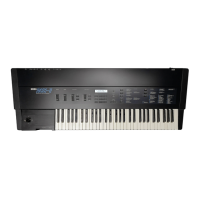■ n ) TR/NT (transpose or no transpose) is a question of
whether to transpose a sound’s pitch or not. Of
course, you would normally set this to TR, so that the
pitch will be transposed and correspond to the key
being played. However, there are some cases when
you may want to obtain the same sound, without any
pitch change, no matter which key you play within the
assigned range. An example of this would be drums.
In this case, set this parameter to NT (no transpose).
■ m) The loop on/off parameter lets you decide whether
you want to repeat a section of the sound or not. Con
trary to the case with the other parameters, the loop
on/off setting affects all the sounds within a particular
multisound. If you turn the loop on, then all sounds in
that multisound will be looped. (Though there is a
way to get around this and keep a particular sound
from appearing to loop. Read on.)
■ IV) The loop start & length parameter is only effective
when the sounds are looped (that is, when the loop
on/off parameter is on). This lets you decide where to
start the loop and how far to continue before looping
again. The loop start point is specified as an address
in memory. The loop length is specified as a number
of memory cells.
We can classify loops by their length into the “short
loop11 and “long loop” categories, each of which has
particular characteristics that we must consider.
A short loop is used to produce a continuous sound
from a sound that you created (by additive synthesis
or hand drawing) or that you obtained by sampling a
single monophonic tone. Ordinarily you would set the
loop length the same as the length of a full cycle of
the waveform. In the case of a short loop, the loop
length will affect the reproduced pitch in the
mathematical relationship shown below, assuming
that you are playing the original key. A shorter length
produces a higher pitch, while a longer length pro
duces a Lower pitch.
Sampling frequency
Pitch at original _ of sound (in Hz)
key (in Hz) ” Loop length
• Example of loop start point and loop length.
This portion is repeated.
• The relationship between loop length and pitch for a
short loop is demonstrated in the example shown
here. With a sampling frequency of 32kHz and loop
length of 20, we can find the looped sound pitch that
will be produced at the original key.
32000
20
= 1600[HzJ
What happens if we change the length to 19?
32000
I9
i=ï 1682(Hz)
What if your sampled sound was originally 1640Hz.
Whether you choose a length of 20 or 19, the looped
portion of the sound will have a pitch that is slightly
lower or higher than the sound before the loop. The
solution is to sample again, adjusting the pitch of the
source to match the pitch that can be obtained with
the particular sampling frequency and loop lengths
' available. '
41

